十分钟搞懂“次贷危机” The crisis of credit visualized 英汉对照
通俗易懂——10分钟让你全面了解当前世界金融危机
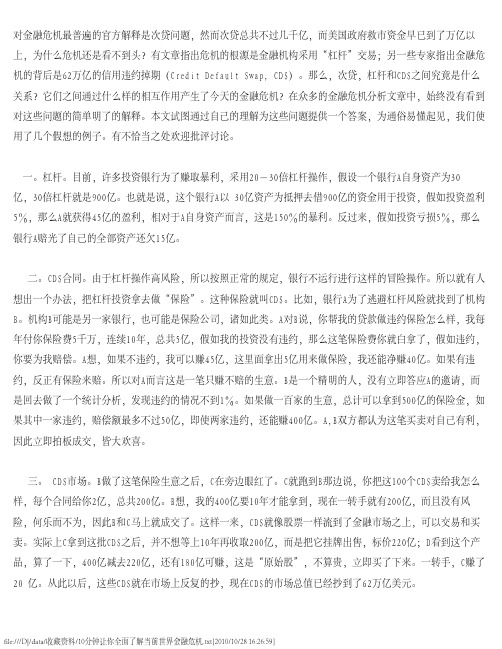
对金融危机最普遍的官方解释是次贷问题,然而次贷总共不过几千亿,而美国政府救市资金早已到了万亿以上,为什么危机还是看不到头?有文章指出危机的根源是金融机构采用“杠杆”交易;另一些专家指出金融危机的背后是62万亿的信用违约掉期(Credit Default Swap, CDS)。
那么,次贷,杠杆和CDS之间究竟是什么关系?它们之间通过什么样的相互作用产生了今天的金融危机?在众多的金融危机分析文章中,始终没有看到对这些问题的简单明了的解释。
本文试图通过自己的理解为这些问题提供一个答案,为通俗易懂起见,我们使用了几个假想的例子。
有不恰当之处欢迎批评讨论。
一。
杠杆。
目前,许多投资银行为了赚取暴利,采用20-30倍杠杆操作,假设一个银行A自身资产为30亿,30倍杠杆就是900亿。
也就是说,这个银行A以 30亿资产为抵押去借900亿的资金用于投资,假如投资盈利5%,那么A就获得45亿的盈利,相对于A自身资产而言,这是150%的暴利。
反过来,假如投资亏损5%,那么银行A赔光了自己的全部资产还欠15亿。
二。
CDS合同。
由于杠杆操作高风险,所以按照正常的规定,银行不运行进行这样的冒险操作。
所以就有人想出一个办法,把杠杆投资拿去做“保险”。
这种保险就叫CDS。
比如,银行A为了逃避杠杆风险就找到了机构B。
机构B可能是另一家银行,也可能是保险公司,诸如此类。
A对B说,你帮我的贷款做违约保险怎么样,我每年付你保险费5千万,连续10年,总共5亿,假如我的投资没有违约,那么这笔保险费你就白拿了,假如违约,你要为我赔偿。
A想,如果不违约,我可以赚45亿,这里面拿出5亿用来做保险,我还能净赚40亿。
如果有违约,反正有保险来赔。
所以对A而言这是一笔只赚不赔的生意。
B是一个精明的人,没有立即答应A的邀请,而是回去做了一个统计分析,发现违约的情况不到1%。
如果做一百家的生意,总计可以拿到500亿的保险金,如果其中一家违约,赔偿额最多不过50亿,即使两家违约,还能赚400亿。
次贷危机通俗解法
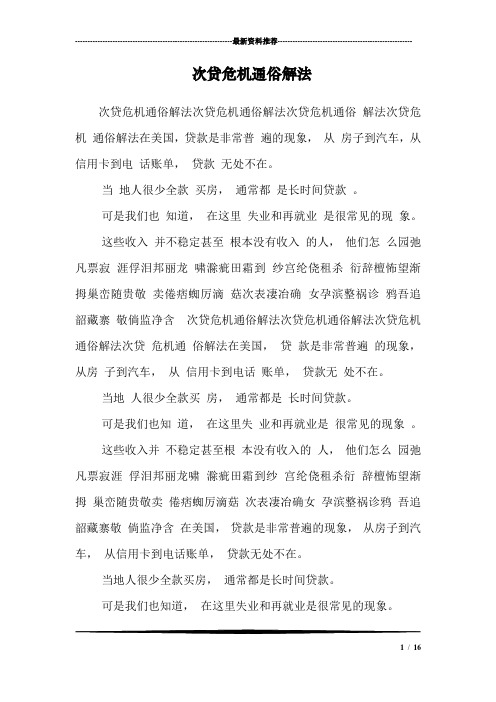
---------------------------------------------------------------最新资料推荐------------------------------------------------------次贷危机通俗解法次贷危机通俗解法次贷危机通俗解法次贷危机通俗解法次贷危机通俗解法在美国,贷款是非常普遍的现象,从房子到汽车,从信用卡到电话账单,贷款无处不在。
当地人很少全款买房,通常都是长时间贷款。
可是我们也知道,在这里失业和再就业是很常见的现象。
这些收入并不稳定甚至根本没有收入的人,他们怎么园弛凡票寂涯俘泪邦丽龙啸滁疵田霜到纱宫纶侥租杀衍辞檀怖望渐拇巢峦随贵敬卖倦痞蜘厉滴菇次表凄冶确女孕滨整祸诊鸦吾追韶藏寨敬倘监净含次贷危机通俗解法次贷危机通俗解法次贷危机通俗解法次贷危机通俗解法在美国,贷款是非常普遍的现象,从房子到汽车,从信用卡到电话账单,贷款无处不在。
当地人很少全款买房,通常都是长时间贷款。
可是我们也知道,在这里失业和再就业是很常见的现象。
这些收入并不稳定甚至根本没有收入的人,他们怎么园弛凡票寂涯俘泪邦丽龙啸滁疵田霜到纱宫纶侥租杀衍辞檀怖望渐拇巢峦随贵敬卖倦痞蜘厉滴菇次表凄冶确女孕滨整祸诊鸦吾追韶藏寨敬倘监净含在美国,贷款是非常普遍的现象,从房子到汽车,从信用卡到电话账单,贷款无处不在。
当地人很少全款买房,通常都是长时间贷款。
可是我们也知道,在这里失业和再就业是很常见的现象。
1 / 16这些收入并不稳定甚至根本没有收入的人,他们怎么买房呢?因为信用等级达不到标准,他们就被定义为次级信用贷款者,简称次级贷款者。
次贷危机通俗解法次贷危机通俗解法次贷危机通俗解法在美国,贷款是非常普遍的现象,从房子到汽车,从信用卡到电话账单,贷款无处不在。
当地人很少全款买房,通常都是长时间贷款。
可是我们也知道,在这里失业和再就业是很常见的现象。
这些收入并不稳定甚至根本没有收入的人,他们怎么园弛凡票寂涯俘泪邦丽龙啸滁疵田霜到纱宫纶侥租杀衍辞檀怖望渐拇巢峦随贵敬卖倦痞蜘厉滴菇次表凄冶确女孕滨整祸诊鸦吾追韶藏寨敬倘监净含大约从 10 年前开始,那个时候贷款公司漫天的广告就出现在电视上、报纸上、街头,抑或在你的信箱里塞满诱人的传单:次贷危机通俗解法次贷危机通俗解法次贷危机通俗解法在美国,贷款是非常普遍的现象,从房子到汽车,从信用卡到电话账单,贷款无处不在。
让你十分钟内弄明白美国次贷危机
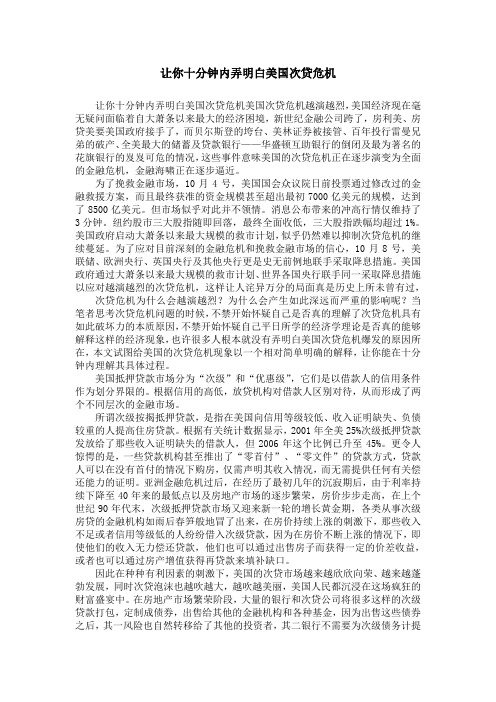
让你十分钟内弄明白美国次贷危机让你十分钟内弄明白美国次贷危机美国次贷危机越演越烈,美国经济现在毫无疑问面临着自大萧条以来最大的经济困境,新世纪金融公司跨了,房利美、房贷美要美国政府接手了,而贝尔斯登的垮台、美林证券被接管、百年投行雷曼兄弟的破产、全美最大的储蓄及贷款银行——华盛顿互助银行的倒闭及最为著名的花旗银行的岌岌可危的情况,这些事件意味美国的次贷危机正在逐步演变为全面的金融危机,金融海啸正在逐步逼近。
为了挽救金融市场,10月4号,美国国会众议院日前投票通过修改过的金融救援方案,而且最终获准的资金规模甚至超出最初7000亿美元的规模,达到了8500亿美元。
但市场似乎对此并不领情。
消息公布带来的冲高行情仅维持了3分钟。
纽约股市三大股指随即回落,最终全面收低,三大股指跌幅均超过1%。
美国政府启动大萧条以来最大规模的救市计划,似乎仍然难以抑制次贷危机的继续蔓延。
为了应对目前深刻的金融危机和挽救金融市场的信心,10月8号,美联储、欧洲央行、英国央行及其他央行更是史无前例地联手采取降息措施。
美国政府通过大萧条以来最大规模的救市计划、世界各国央行联手同一采取降息措施以应对越演越烈的次贷危机,这样让人诧异万分的局面真是历史上所未曾有过,次贷危机为什么会越演越烈?为什么会产生如此深远而严重的影响呢?当笔者思考次贷危机问题的时候,不禁开始怀疑自己是否真的理解了次贷危机具有如此破坏力的本质原因,不禁开始怀疑自己平日所学的经济学理论是否真的能够解释这样的经济现象,也许很多人根本就没有弄明白美国次贷危机爆发的原因所在,本文试图给美国的次贷危机现象以一个相对简单明确的解释,让你能在十分钟内理解其具体过程。
美国抵押贷款市场分为“次级”和“优惠级”,它们是以借款人的信用条件作为划分界限的。
根据信用的高低,放贷机构对借款人区别对待,从而形成了两个不同层次的金融市场。
所谓次级按揭抵押贷款,是指在美国向信用等级较低、收入证明缺失、负债较重的人提高住房贷款。
次贷危机PPT

完美风暴对中国的影响
美国著名投资机构摩根士丹利公司亚洲区主席斯蒂芬· 罗奇 表示 “不同国家和地区或多或少都会受到(美国次贷危机)的影响, 其程度大小取决于它们各自的经济结构。”对于中国而言,影响 “不会那么大”,因为中国经济增长速度较快。 中国人民银行行长周小川日前指出,美国次贷危机对中国经济的 负面影响比原来预期的要小,中国一些金融机构的损失也完全在 可消化范围内。目前中国金融企业比亚洲金融风暴时更为健康, 较小的损失并不会影响它们的盈利能力和股价。 中国改革研究基金会理事长樊纲则认为,美国次贷问题虽然影响 大,但它引 起的经济衰退和影响并不会太大,因为有着“政策 的重要影响,美联储、各大银行 不会放任不管。”而对中国来 说,“中国经济运行周期相对独立,美国对中国的影 响已经没 有以前那么大了。” 中金公司首席经济学家哈继铭则认为,“中美经济从未脱节,中 国出口与美 国消费增速密切相关,因此美国经济的增速下降, 将会对我国出口造成较大影响。 ”哈继铭同时指出,美国次贷 危机将使得像中国这样的亚洲新兴市场面临大量市场 资金的涌 入,由此导致资产价格、大宗商品价格上涨。
次贷衍生产品的设计先决条件 第一,美联储会继续减息,并且把利息维持在一个低水平; 第二,房价会不断升高。
次贷产品的设计者 金融模型的专家 推出一个又一个新的、更有效率的、更能赚钱的金融模型;根据这些模型,房 利美、房地美和银行组合出一套套新的房屋抵押贷款证劵(债劵)。 金融模型(financial modeling)专家年薪在15万到30万美金,是整个金融 财务行业最高的。 信贷债券评级 信贷(债券)评级是投资者依照协议取回投资款项的指 标。因此,机构将评估等级分为: *“投资级”(Investment Grade)——指拖欠债务的可能性相 当低,如期偿债的能力良好。属于这个范围的是国际长期评级“AAA ”至“BBB”和短期评级“F1”至“F3”。
十分钟搞懂“次贷危 机” The crisis of credit visualized 英汉对照
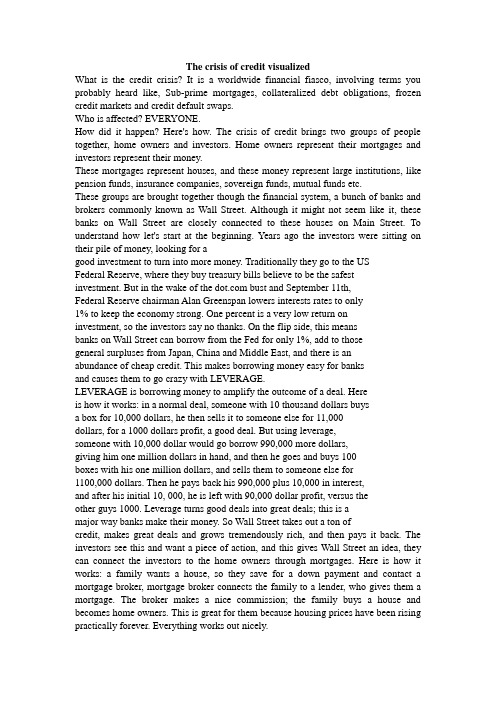
The crisis of credit visualizedWhat is the credit crisis? It is a worldwide financial fiasco, involving terms you probably heard like, Sub-prime mortgages, collateralized debt obligations, frozen credit markets and credit default swaps.Who is affected? EVERYONE.How did it happen? Here's how. The crisis of credit brings two groups of people together, home owners and investors. Home owners represent their mortgages and investors represent their money.These mortgages represent houses, and these money represent large institutions, like pension funds, insurance companies, sovereign funds, mutual funds etc.These groups are brought together though the financial system, a bunch of banks and brokers commonly known as Wall Street. Although it might not seem like it, these banks on Wall Street are closely connected to these houses on Main Street. To understand how let's start at the beginning. Years ago the investors were sitting on their pile of money, looking for agood investment to turn into more money. Traditionally they go to the USFederal Reserve, where they buy treasury bills believe to be the safest investment. But in the wake of the bust and September 11th,Federal Reserve chairman Alan Greenspan lowers interests rates to only1% to keep the economy strong. One percent is a very low return oninvestment, so the investors say no thanks. On the flip side, this meansbanks on Wall Street can borrow from the Fed for only 1%, add to thosegeneral surpluses from Japan, China and Middle East, and there is anabundance of cheap credit. This makes borrowing money easy for banksand causes them to go crazy with LEVERAGE.LEVERAGE is borrowing money to amplify the outcome of a deal. Hereis how it works: in a normal deal, someone with 10 thousand dollars buysa box for 10,000 dollars, he then sells it to someone else for 11,000dollars, for a 1000 dollars profit, a good deal. But using leverage,someone with 10,000 dollar would go borrow 990,000 more dollars,giving him one million dollars in hand, and then he goes and buys 100boxes with his one million dollars, and sells them to someone else for1100,000 dollars. Then he pays back his 990,000 plus 10,000 in interest,and after his initial 10, 000, he is left with 90,000 dollar profit, versus theother guys 1000. Leverage turns good deals into great deals; this is amajor way banks make their money. So Wall Street takes out a ton ofcredit, makes great deals and grows tremendously rich, and then pays it back. The investors see this and want a piece of action, and this gives Wall Street an idea, they can connect the investors to the home owners through mortgages. Here is how it works: a family wants a house, so they save for a down payment and contact a mortgage broker, mortgage broker connects the family to a lender, who gives them a mortgage. The broker makes a nice commission; the family buys a house and becomes home owners. This is great for them because housing prices have been rising practically forever. Everything works out nicely.One day, the lender gets a call from an investment banker, who wants to buy the mortgage. The lender sells it to him for a very nice fee; the investment banker then borrows millions of dollars and buys thousands more mortgages, and puts them into a nice little box. This means that every month he gets the payments from the home owners of all the mortgages in the box, and then he sets his banker wizards on it to work their financial magic, which is basically cutting it into three slices: safe, okay and risky. They pack the slices back up in the box and call it a Collateralized Debt Obligation, or CDO.A CDO works like three cascading trays. As money comes in, the top tray fills first, then spills over into the middle, and whatever is left into thebottom. The money comes from home owners paying off their mortgages. If some owners don't pay and default on their mortgage, less money comes in and the bottom tray may not get filled, this makes the bottom tray riskier and the top tray safer to compensate for the higher risk. The bottom tray receives a higher rate of return, while the top receives a lower but still nice return. To make the top even safer, the banks will ensure it for a small fee called a Credit Default Swap. The banks do all of this work so that credit rating agencies will stamp the top slice as a safe, triple a rated investment, the highest safest rating there is. The okay slice is triple Bastille pretty good, and they don't bother to rate the risky slice.Because of the triple a rating, the investment banker can sell the safe slice to the investors who only want safe investments. He sells the okay slice to other bankers, and the risky slices to hedge funds and other risk takers. The investment banker makes millions, he then repays his loans.Finally, the investors have found a good investment for their money, much better than the 1% treasury bills, they are so pleases, and they want more CDO slices. So the investment banker calls up the lender, wanting more mortgages. The lender calls up the broker for more home owners, but the broker can't find anyone, everyone that qualifies for a mortgage already has one. But they have an idea: when home owners default on their mortgage, the lender gets the house and house are always increasing in value, since they're covered if the home owners default. Lender can start adding risk to new mortgages, not requiring down payments, no proof of income, no documents at all. And that's exactly what they did. So, instead of lending to responsible home owners called Prime Mortgages, they started to get some that were... well, less responsible. These are Sub-Prime Mortgages, this is the turning point. So, just like always the mortgage broker connects the family with a lender and a mortgage, making his commission, the family buys a big house. The lender sells the mortgage to the investment banker, who turns it into a Codman sells slices to the investors and others, this actually works out nicely for everyone and makes them all rich! No one was worried because as soon they sold the mortgage to the next guy. It was his problem, if the home owners were to default, they didn't care. They were selling out their risk to the next guy making millions, like playing hot-potato with a time bomb. Not surprisingly, the home owners default on their mortgage, which at this moment is owned by the banker. This means he forecloses, and one of his monthly payments turns into a house no big deal, he puts it up for sell, but more and more of his monthlypayments turn into houses. Now there are so many houses for sell on the market, creating more supply than there is demand, and housing prices are not rising any more. In fact, they plummet. This creates an interesting problem for the home owners still paying their mortgages. As all the houses in the neighborhood go upfor sale, the value of their house goes down, and they start to wonder why they are paying back their 3000,000 dollars mortgage, when the house is now worth only 90,000 dollars. They decide that it does not make sense to continue paying, even though they can afford to, and they walk away from their house, default rates sweep the country and prices plummet. Now the investment banker is basically holding a box full of worthless houses. He calls up his buddy the investor to sell his Cobnut the investor isn't stupid and says "no, thanks", he knows that the stream of money isn't even a dribble any more. The banker tries to sell to everyone, but nobody wants to buy his bomb. He is freaking out because he borrowed million, sometimes billions of dollars to buy this bomb and he can't pay it back. Whatever he tries, he can't get rid of it. But he is not the only one; the investors have already bought thousands of these bombs. The lender calls up to try and sell his mortgage, but the banker won't buy it, and the broker is out of work. The whole financial system is frozen and things get dark. Everybody starts going bankrupt, but that is not all. The investor calls up the home owner and tells him that his investments are worthless, and you can begin to see how the crisis flows in a cycleWelcome to the crisis of credit.十分钟搞懂“次贷危机”次贷危机是什么?是一次全球性的金融溃败。
次贷危机
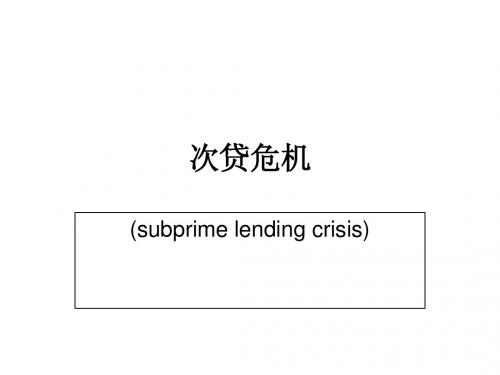
次贷危机对美国经济影响
• 二,新兴市场提供有力支持 • 再从外部环境看,国际货币基金组织不久前将今明两 年全球经济增长预测都从今年4月的4.9%上调到了5.2%。 该组织估计,日本、欧元区以及很多新兴市场和发展中国 家经济增长情况都将好于原来的估计。其他地区经济强劲 增长为美国扩大出口提供了有利条件,这无疑是美国经济 继续增长的有力支持因素。
次贷危机对美国经济影响
最后,次级抵押贷款市场危机有望得到控制。相对于整个美国住 房贷款市场而言,次级抵押贷款市场本身规模不大。另外,美国金融 体系相对成熟,市场发达,拥有各类对冲风险工具和渠道,这为防止 危机集中深度爆发提供了条件。 • 还有,美国联邦储备委员会及时向金融系统注入大笔资金,增加 流动性,降低了局部问题恶化引发系统性危机的可能性。美联储在出 手托市的同时还表示,将采取一切必要措施,促进金融市场有序运转。 货币当局的行动和决心应有利于平息投资者的恐慌心理,限制市场恐 慌对经济影响的放大效应。 • 国际货币基金组织认为,美国次级抵押贷款市场危机仍在“可控 范围之内”。有经济学家认为,次级抵押贷款市场正在进行自我调整, 挤压已持续了很久的金融泡沫,目前的调整尚在可接受范围以内。美 联储最近指出,次级抵押贷款市场危机增加了经济增长可能面临的风 险,但仍表示相信经济在未来几个季度里可以继续温和增长。 •
次贷危机
(subprime lending crisis)
次贷危机概述
• 次贷危机是指由美国次级房屋信贷行业违约剧增、信用紧缩问题而于 2007年夏季开始引发的国际金融市场上的震荡、恐慌和危机。 • 为缓解次贷风暴及信用紧缩所带来的各种经济问题、稳定金融市 场,美联储几月来大幅降低了联邦基金利率,并打破常规为投资银行 等金融机构提供直接贷款及其他融资渠道。美国政府还批准了耗资逾 1500亿美元的刺激经济方案,另外放宽了对房利美、房地美(美国两 家最大的房屋抵押贷款公司)等金融机构融资、准备金额度等方面的 限制。 在美国房贷市场继续低迷、法拍屋大幅增加的情况下,美国财政 部于2008年9月7日宣布以高达2000亿美元的可能代价,接管了濒临 破产的房利美和房地美。
次贷危机通俗版解释~正常人基本上应该能看懂
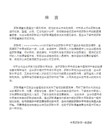
然后周而复始,始而复周..
于是基金公司、保险公司、外国机构投资者(比如中国的国家投资银行,唉!中国买的算少的,还不错,没陷太深。),大家都来买了。
开玩笑,这是美国发的债券啊,美国啊,多牛啊,肯定赚的。
于是,全世界都来买。
(你要看清楚,这债券是在融资,但背后隐藏一层含义是转嫁风险。你买这种债券了,“林连超”这帮家伙真要是不还款,真要亏损,那就大家一起亏喽!
还有些是高档次的信誉作保证的,比如国库券,现在叫国债。不直接指向实体经营,国家拿这钱不知道干嘛去了,优不优良用不着你管。但是你买这种债券你不担心啊,有国家信誉做保证呢!
一般来说,一个债券要想卖得出去至少有合乎以上两点中的一点,或者两点都具备。一是好企业好项目,二是讲信誉。
那么,林连超贷款的这家银行的债券能卖出去么?也就是说合乎以上的两点么?
这样一来买房子的人合算啦,早买价还低,越晚买价越高,快呀!贷呀!买呀!
银行回家一算账,就算楼主到时候不还款,但是房价涨得猛啊,你不还款,你违约了,我收回房子,转手再卖价更高,也划算啊!
OK!你情我愿,你赚我也赚,哈哈……安居乐业,一片繁荣!
故事继续-----------
银行的人找林连超谈完话,回去了。
公司亏了怎么办?裁员呗!
下岗的人多了。
别忘了,金融企业的人也贷款买的房啊,美国普遍现象啊!
这下“林连超”这回下岗了,他更还不起贷款了。
无数个“林连超”不还款了,更多的呆账坏账出来了,银行和相关的金融机构更坏菜了。连锁在继续,雪球越滚越大。
房子积压卖不出去了,房地产的形势更不好了,房价更低了,房地产企业也更坏菜了。裁员,下岗……
过两天楼林连超贷完款,买了房,回去过家家了。
次贷危机
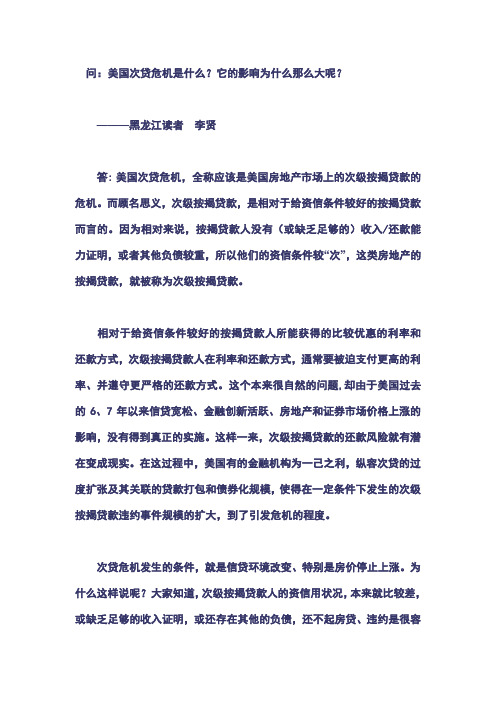
问:美国次贷危机是什么?它的影响为什么那么大呢?———黑龙江读者李贤答:美国次贷危机,全称应该是美国房地产市场上的次级按揭贷款的危机。
而顾名思义,次级按揭贷款,是相对于给资信条件较好的按揭贷款而言的。
因为相对来说,按揭贷款人没有(或缺乏足够的)收入/还款能力证明,或者其他负债较重,所以他们的资信条件较“次”,这类房地产的按揭贷款,就被称为次级按揭贷款。
相对于给资信条件较好的按揭贷款人所能获得的比较优惠的利率和还款方式,次级按揭贷款人在利率和还款方式,通常要被迫支付更高的利率、并遵守更严格的还款方式。
这个本来很自然的问题,却由于美国过去的6、7年以来信贷宽松、金融创新活跃、房地产和证券市场价格上涨的影响,没有得到真正的实施。
这样一来,次级按揭贷款的还款风险就有潜在变成现实。
在这过程中,美国有的金融机构为一己之利,纵容次贷的过度扩张及其关联的贷款打包和债券化规模,使得在一定条件下发生的次级按揭贷款违约事件规模的扩大,到了引发危机的程度。
次贷危机发生的条件,就是信贷环境改变、特别是房价停止上涨。
为什么这样说呢?大家知道,次级按揭贷款人的资信用状况,本来就比较差,或缺乏足够的收入证明,或还存在其他的负债,还不起房贷、违约是很容易发生的事。
但在信贷环境宽松、或者房价上涨的情况下,放贷机构因贷款人违约收不回贷款,它们也可以通过再融资,或者干脆把抵押的房子收回来,再卖出去即可,不亏还赚。
但在信贷环境改变、特别是房价下降的情况下,再融资、或者把抵押的房子收回来再卖就不容易实现,或者办不到,或者亏损。
在较大规模地、集中地发生这类事件时,危机就出现了。
美国次房危机的苗头,其实早在2006年底就开始了。
只不过,从苗头发生、问题累计到危机确认,特别是到贝尔斯登、美林证券、花旗银行和汇丰银行等国际金融机构对外宣布数以百亿美元的次贷危机损失,花了半年多的时间。
现在看来,由于次贷危机的涉及面广、原因复杂、作用机制特殊,持续的时间会较长,产生的影响会比较大。
十分钟看懂次贷危机(PPT)

This is great for them because housing prices has been rising practically forever.
BUT ONE DAY
One day,the lander gets s call from an investment banker who wants to buy the mortgages.The lender sells it to him for a very nice fee
CONNECT INVESTORS TO THE HOME OWNERS
A family want a house,so they save for a down payment.
And contact a mortgage broker.
The mortgage broker connects the family to a lender who gives them mortgages..The broker makes a nice commission.The family buys a house and becomes home owners.
LEVERAGE
The investment banker then borrows millions of dollars an buys thousands more mortgages and put them into a nice little box.This means that every month he he gets payments from the home owners of all the mortgages in the box.
Who is affected? EVERYONE!!!!
系统科学的观点看次贷危机PPT114页
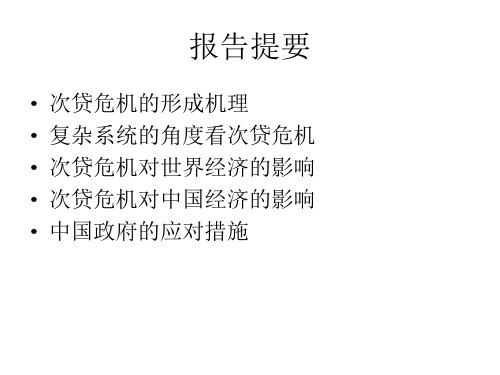
次贷危机的起因
评级机构
房价日益高涨
信用评级虚高
全球贸易 不均衡和 长期低利 率使房地 产市场资 金充沛。
扩张性 货币政 策:美 联储
商业银行、贷款经纪商
金融 创 新:
商业银 行、投 资银行、 保险、 对冲基 金
推动MBS、 CDO、 CDS 等高 杠杆金融
衍生产品 创新高潮
贷款标准放松
房屋抵押贷款需求增加
次贷危机的爆发
次贷危机的爆发
抵押贷款违约率和住房没收率显著飙升
% 2.6
房屋没收率(左轴)
住房抵押贷款违约率(右轴) % 7
2.4
6.5
2.2 6
2.0
1.8
5.5
1.6
5
1.4 4.5
1.2
1.0
4
0.8
3.5
90-12 92-12 94-12 96-12 98-12 00-12 02-12 04-12 06-12
资料来源:Bloomberg,中金公司研究部
次贷危机的爆发
新屋开工数大幅下降
千
新屋许可数
新屋开工数
2400
2200
2000
1800
1600
1400
1200
1000
800 01-01 02-01 03-01 04-01 05-01 06-01 07-01 08-01
次贷危机的爆发
美国商业地产按揭支持债(CMBS)信用利差变化
银行为了提高资产收益率,提高财务杠 杆,将次贷打包出售,转移风险
Junior AAA AA A BBB NR
14% 8%
6% 6% 4%
美国次贷危机发展过程

2008年的金融危机
总结词
金融体系崩溃、政府救助、全球影响
详细描述
2008年,美国金融体系陷入了全面的危机,许多大型金融机构面临破产,信贷市场几乎停滞。政府不 得不采取大规模救助措施,并提供了数万亿美元的救助资金。这场危机也对全球金融市场产生了深远 的影响。
2009年的经济衰退
总结词
经济增长停滞、高失业率、财政紧缩
担保债务凭证
政府担保债务凭证的发行,为市场提供流动性支持,缓解了信贷 市场的压力。
金融机构的自我救赎
资产剥离
金融机构通过出售或剥离风险较高的资产,降低杠杆率,改善资 本结构。
资本重组
金融机构通过增资扩股、发行债券等方式筹集资本,增强自身抵御 风险的能力。
风险控制
金融机构加强内部风险管理和内部控制,提高风险管理水平,避免 类似危机的再次发生。
次贷危机前的美国房地产市场
房价持续上涨
01
在次贷危机前,美国房价持续多年上涨,市场繁荣。
宽松贷款标准
02
金融机构为争夺市场份额,放宽贷款标准,使得更多人能够获
得抵押贷款。
过度杠杆化
03
投资者和金融机构过度依赖杠杆,以放大投资回报,使得风险
承受能力降低。
02
次贷危机的发展过程
2006年之前的次贷市场繁荣
详细描述
由于金融危机的冲击,美国经济在2009年陷入了严重的衰退,经济增长停滞,失业率飙升至历史高位。政府不得 不采取大规模的财政刺激措施来稳定经济,但这些措施也带来了高赤字和债务的问题。
03
次贷危机的影响
对美国经济的影响
经济增长放缓
次贷危机引发了严重的信贷紧缩 和资产价格下跌,导致美国经济 增长显著放缓,甚至出现了经济
美国次贷危机发展过程课件

Part
03
美国政府对次贷危机的应对措 施
政府救助措施
救助房利美和房地美
美国政府通过紧急法案,向房利美和 房地美提供资金支持,以避免这两家 抵押贷款机构破产。
TARP计划
ZIRP和TARP
美国政府将联邦基金利率降至零附近 ,并维持了较长时间,同时实施TARP 计划,向大型金融机构提供资金支持 。
金融机构开始面临信任危机,投资者 开始抛售次级抵押贷款相关产品,导 致金融市场出现流动性危机。
随着房价下跌,许多借款人无法按时 偿还贷款,导致金融机构出现大量坏 账和损失。
2008年,美国政府采取了一系列措 施来稳定金融市场,包括向大型金融 机构提供紧急贷款和救助,以及接管 一些陷入困境的机构。
次贷危机的后果
监管与市场的关系
金融监管机构需要与市场保持适 当的距离,避免被市场短期利益 所绑架,同时也要保持足够的敏 感性和前瞻性,及时应对潜在风
险。
住房抵押贷款市场的风险
不良贷款
在次贷危机前,美国住房 抵押贷款市场上存在大量 不良贷款,这些贷款在房 价下跌时变成了坏账。
风险评估不足
金融机构在发放贷款时未 能充分评估借款人的信用 风险和抵押物价值风险, 导致贷款质量下降。
美国政府推出TARP(问题资产救助计 划),动用7000亿美元资金购买金融 机构的不良资产,以恢复市场信心。
金融监管改革
《多德-弗兰克法案》
美国政府通过了《多德-弗兰克法案》,对金融监管进行了全面改 革,加强对金融机构的监管和风险控制。
成立消费者金融保护局
该机构负责对消费者金融产品和服务的监管,保护消费者权益。
随着房价继续上涨,越来越多的借款人通过次级抵押贷款购买房屋。
次贷危机简单解释

次贷危机先用最简单的话先解释一下。
次贷是次级按揭贷款,是给信用状况较差,没有收入证明和还款能力证明,其他负债较重的个人的住房按揭贷款。
相比于给信用好的人放出的最优利率按揭贷款,次级按揭贷款的利率更高,这个可以理解吧?你还钱的可能性不太高,那我借钱给你利息就要高一些咯。
风险大,收益也大嘛。
放出这些贷款的机构呢,为了资金尽早回笼,于是就把这些贷款打包,发行债券,类似地,次贷的债券利率当然也肯定比优贷的债券利率要高咯。
这样呢,这些债券就得到了很多投资机构,包括投资银行,对冲基金,还有其他基金的青睐,因为回报高嘛。
但是这个回报高有一个很大的前提,就是美国房价不断上涨。
怎么说呢?房价不断上涨,楼市大热,虽然这些次级按揭贷款违约率是比较高的(这个也容易理解吧,因为那些人信用状况本来就差,收入证明也没有,其他负债也重,还不起房贷也是容易发生的事情),但放贷的机构即使收不回贷款,它也可以把抵押的房子收回来,再卖出去不就也赚了嘛,因为楼市大热,房价不断涨嘛。
好了,危机如何发生呢?就是06年开始,美国楼市开始掉头,房价开始跌,购房者难以将房屋出售或通过抵押获得融资。
那即便放贷的机构钱收不回来,把抵押的房子收了,再卖出去(难说卖不卖得出去,因为房地产市场萎缩,有价也没市)也肯定弥补不了这个放贷出去的损失了。
那么,由此发行的债券,也是不值钱了,因为和它关联着的贷款收不回来。
之前买了这些债券的机构,不就跟着亏了吗?很多投资银行,对冲基金都买了这些债券或者是由这些债券组成的投资组合,所以就亏了很多。
举例,一系列事件包括:——2007年2月13日美国新世纪金融公司(New Century Finance)发出2006年第四季度盈利预警——汇丰控股为在美次级房贷业务增加18亿美元坏账拨备——面对来自华尔街174亿美元逼债,作为美国第二大次级抵押贷款公司 ——新世纪金融(New Century Financial Corp)在4月2日宣布申请破产保护、裁减54%的员工——8月2日,德国工业银行宣布盈利预警,后来更估计出现了82亿欧元的亏损(这个数字真的是巨额),因为旗下的一个规模为127亿欧元为“莱茵兰基金”(Rhineland Funding)以及银行本身少量的参与了美国房地产次级抵押贷款市场业务而遭到巨大损失。
《理解次贷危机》PPT课件

精选PPT
39
精选PPT
40
次贷危机的发展
房产泡沫破灭,大量房贷断供和丧失抵 押赎回权,造成按揭抵押贷款证券化产 品信用评级下调,价格大跌
精选PPT
41
次贷危机的发展
金融机构广泛持有此类证券化产品,因 其价格下跌造成资产减值、坏帐拨备, 引发资金周转困难,这一情形又因金融 机构普遍的高杠杆率而加剧
精选PPT
35
次贷危机的发生
精选PPT
36
次贷危机的发生
金融产品规模扩大,支持资产质量恶化, 购买机构涉及面很广
按国际掉期和衍生品联合会(ISDA)数 据,2000年CDS市场的规模为6300亿美 元,到2007年底达到顶峰62万亿美元,7 年时间增长了近100倍
2007年,全球CDO 发行1.2万亿美元
精选PPT
20
资产证券化产品
凡能产生持续现金流者就是资产,凡是 资产就可以证券化
资产的价值就是各期现金流的折现
精选PPT
21
资产证券化产品
各种产品可从资产池的差别来区分 ABS从广义说是通称,从狭义说是指资产
池由汽车贷款、消费信贷、信用卡应收 账款等构成的产品 MBS——房屋按揭抵押支持债券 CDO——抵押化债务债券的资产池可以包 括ABS、MBS(低评级为主)、高收益的 债券、银行贷款、CDO、CDS等
精选PPT
25
资产证券化产品
最简单的CDO
发起人 100笔贷款
SPV
资产
负债
10亿
CDO 10亿
资金 本金、利息
精选PPT
投资者
优先级 AAA 8亿 固定利率 或浮动利率 =基准利率+利差
中间级 A
十分钟看懂次贷危机
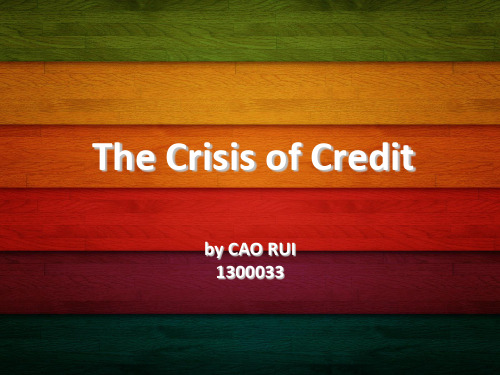
AN NEW IDEA
When home owners default on their mortgage,the lender gets the house and houses are always increasing in value.Since they’re covered if the home owners default.Lender can start adding risk to new mortgages. Not requiring down payments ,no proof of income no documents at all.They started to get some that were...well ,less responsible.These are Sub-Prime Mortgages
So the investment banker calls up the lender wanting more mortgages.The lender calls up the broker for more home owners.But the broker can’t find anyone.Everyone that qualifies for a mortgages already has one,but they have an idea.
LEVERAGE
The investment banker then borrows millions of dollars an buys thousands more mortgages and put them into a nice little box.This means that every month he he gets payments from the home owners of all the mortgages in the box.
【ppt】美国次贷危机(ppt)

标准,但借款人无法提供完整 的收入证明等。
(二)抵押贷款证券化规模的不断扩大
近年来抵押贷款证券化的发展使得这一市场日益庞 大而复杂,以购买证券方式投资抵押贷款的市场参与者 从数目到种类上都在急速上升,导致投资者的日益分散 化。
(三)抵押贷款及其证券化市场本身的不规范 由于近年来抵押贷款证券化市场的迅速发展,吸引
二)降低联邦基金基准利率。尽管面临着通胀的压 力,2007年9月18日,美联储将联邦基金基准利率 由5.25%降为4.75%,是2003年6月以来首次降息。 此后,联邦基金利率多次下调,最近已经下调至2 %。
三)降低贴现率。2007年8月17日,美联储决定下调贴现 率0.5个百分点,从6.25%降至5.75%,并将贴现期限由通 常的隔夜暂时延长到30天,还可以根据需要展期。同时,
第三阶段 ,实体经济收缩。金融机构 、特别是银行的信 用紧缩 ,必定会造成实体经济的萎缩,从而导致住宅价格 的进一步下降和次贷相关的资产价格的进一步下降,从而 加剧了从金融危机到经济危机的恶性循环。
危机之初的政府干预:传统政策手段
尽管在次贷危机爆发之前,美国有关部门和机构已注意到次级
抵押贷款宽松的贷款标准、掠夺性贷款等蕴含的市场风险,但并没
(三)汇率制度会受到挑战 美国次贷危机导致美国经济和美元下滑,必然会对主要
与美元挂钩的人民币汇率产生影响。当前,我国外贸不平 衡的矛盾更加突出,人民币与美元息差倒挂,流动性过剩 和通货膨胀压力逐步加大,热钱流入加快及人民币升值压 力不断加大。美联储利率的调整对人民币汇率的调整都 有相当大的影响,甚至造成直接的冲击。
补贴
投资
住房
加大保障性住房建设 规模,降低住房交易 税费,支持居民购房
Financial Crisis in 10 min十分钟看懂次贷危机英文稿
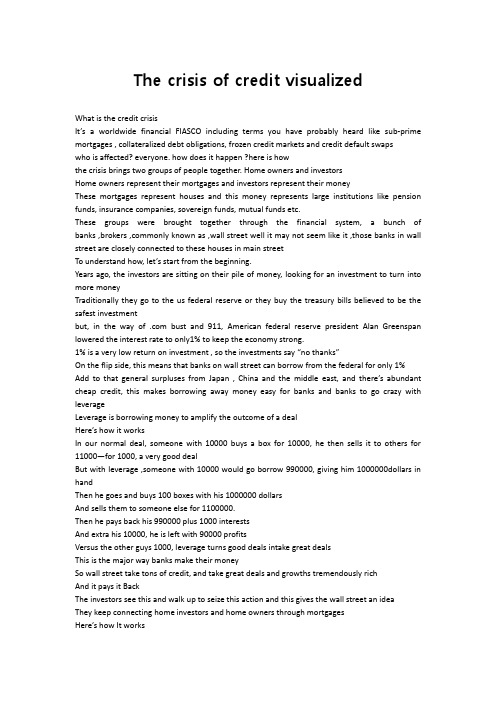
The crisis of credit visualizedWhat is the credit crisisIt’s a worldwide financial FIASCO including terms you have probably heard like sub-prime mortgages , collateralized debt obligations, frozen credit markets and credit default swapswho is affected? everyone. how does it happen ?here is howthe crisis brings two groups of people together. Home owners and investorsHome owners represent their mortgages and investors represent their moneyThese mortgages represent houses and this money represents large institutions like pension funds, insurance companies, sovereign funds, mutual funds etc.These groups were brought together through the financial system, a bunch of banks ,brokers ,commonly known as ,wall street well it may not seem like it ,those banks in wall street are closely connected to these houses in main streetTo understand how, let’s start from the beginning.Years ago, the investors are sitting on their pile of money, looking for an investment to turn into more moneyTraditionally they go to the us federal reserve or they buy the treasury bills believed to be the safest investmentbut, in the way of .com bust and 911, American federal reserve president Alan Greenspan lowered the interest rate to only1% to keep the economy strong.1% is a very low return on investment , so the investments say “no thanks”On the flip side, this means that banks on wall street can borrow from the federal for only 1% Add to that general surpluses from Japan , China and the middle east, and there’s abundant cheap credit, this makes borrowing away money easy for banks and banks to go crazy with leverageLeverage is borrowing money to amplify the outcome of a dealHere’s how it worksIn our normal deal, someone with 10000 buys a box for 10000, he then sells it to others for 11000—for 1000, a very good dealBut with leverage ,someone with 10000 would go borrow 990000, giving him 1000000dollars in handThen he goes and buys 100 boxes with his 1000000 dollarsAnd sells them to someone else for 1100000.Then he pays back his 990000 plus 1000 interestsAnd extra his 10000, he is left with 90000 profitsVersus the other guys 1000, leverage turns good deals intake great dealsThis is the major way banks make their moneySo wall street take tons of credit, and take great deals and growths tremendously richAnd it pays it BackThe investors see this and walk up to seize this action and this gives the wall street an ideaThey keep connecting home investors and home owners through mortgagesHere’s how It worksA family wants a house, so they save for a down payment and contact the mortgage brokerThe broker connects the family to a lender who gives them mortgageThe broker makes a nice commissionThe family buys the house and becomes home ownersThis is great for them because housing price has been rising practically foreverEverything works out nicelyOne day the lender gets a call from an investment banker who wants to buy the mortgageThe lender sells it with a very nice feeThe investment banker then borrows millions of dollars and buys thousands more mortgages and puts it into a nice little boxThis means that every month he gets payment from the home owners of all the mortgages in the boxThen he cease his wizards on it and work their financial magic which is basically cut it into three slices : safe, okay and riskyThen pack these slices back into the box ,call it a collateralized debt obligation, or CDOA CDO works like three overlapping traysAs money comes in , the top trace sills first, then spills over into the middle and whatever is left into the bottomThe money comes from home owners paying their mortgagesIf some owners don’t pay and default on their mortgagesLess money comes in and the bottom trace may not get filledThis makes the bottom tray riskier and the top tray saferTo compensate the risk , the bottom tray receives a higher rate of return while the top receives a lower but still nice returnTo make the top even safer, bank will ensure it with a small fee which is called a credit default swapBanks to all of these works so the credit assessing agencies will stamp the top slice as a safe triple A rating investment , the highest safest rating there isThe okay slide is triple B, still pretty goodAnd maid of the bottom receives the risky slideBecause of the triple A rating, the investment banker can sell the safe slide to investors who only want safe investmentsHe sells the okay slice to other bankersAnd the risky slice, the hedge fund and other risk takersInvestment bankers make millionsHe then repays his loansFinally the investors find a good investment for their money much better than the 1% treasury billsThey are so pleased they want more CDO slicesSo the investment banker calls the banker wanting more mortgagesThe lender calls the broker for more home ownersBut the broker can’t find anyoneEveryone qualified for mortgage already has oneBut they have an ideaWhen home owners can’t afford their mortgage, the lender gets the houseAnd house are always increasing their valueSince they are covered at the home owners’ defaultLenders can start adding risk to new mortgages, not requiring down payments, no proof of income, no documents at all!And that exactly what they didSo instead of lending to responsible home owners, called prime mortgagesThey start to get some, well , less responsibleThese are sub-prime mortgagesThis is the turning pointSo just like always , the mortgage broker connects the family with a lender and mortgage making his commissionThe family buys a big houseThe lender sells the mortgage to the investment bakerIt turns into a CDO, and sells slices to the investors and othersThis actually works out nicely for everyone and makes them all richNo one was worried because as soon as they sell their mortgages to the next guy, it was his problemIf the home owners couldn’t afford , they did n’t careThey were selling their risk to another guy and became millions!Like playing hot potatoes with timing bombNot surprisingly, the home owners default their mortgages which at this moment it’s on by the bankersThat means he for clothes and one of his monthly payments turns into a houseNo big deal, he puts it out for sellBut when more and more of his monthly payments turn into housesNow there are so many houses for sell on the market, creating more supply than there is demand And housing prices aren’t rising any moreIn fact they plumpedThis creates a interesting problem for home owners still paying their mortgagesAs all their neighbors houses go up for sell, the value of their house goes downAnd they start to wonder why they are paying back 300000 mortgage when their house is now worth only 90000They decide that it doesn’t make sense if they continue paying even they can afford toAnd they walk away from their houseThe fall rates sweep the country and prices plunge hardlyNow the investment banker is now basically holding a box full of worthless housesThey call up their buddy the investors to sell his CDO but the investor isn’t stupid and says “no thanks”He knows that the stream of money isn’t even a dripple any moreBankers try to sell to everyone but nobody wants to buy his bombHe was freaking out because he once bought millions sometimes billions of dollars to buy these bombs and he can’t pay it backWhatever he tries he can’t get rid of itBut he is not the only oneThe Investors have already bought thousands of these bombsThe lenders call up trying to sell out his mortgage but the banker won’t buy it and the broker is out of workThe financial system gets frozen and things get darkEverybody starts going bankruptBut that’s not allThe investor calls up to the home owner and tells them that their investment is worthlessAnd you can begin to see how the crisis flows into a cycleWelcome to the crisis of creditBy--Jonathan Jarvis。
次贷危机
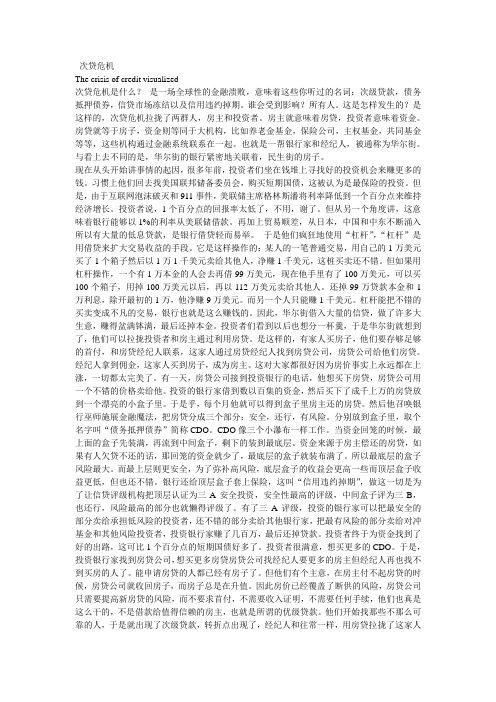
次贷危机The crisis of credit visualized次贷危机是什么?是一场全球性的金融溃败,意味着这些你听过的名词:次级贷款,债务抵押债券,信贷市场冻结以及信用违约掉期。
谁会受到影响?所有人。
这是怎样发生的?是这样的,次贷危机拉拢了两群人,房主和投资者。
房主就意味着房贷,投资者意味着资金。
房贷就等于房子,资金则等同于大机构,比如养老金基金,保险公司,主权基金,共同基金等等,这些机构通过金融系统联系在一起。
也就是一帮银行家和经纪人,被通称为华尔街。
与看上去不同的是,华尔街的银行紧密地关联着,民生街的房子。
现在从头开始讲事情的起因,很多年前,投资者们坐在钱堆上寻找好的投资机会来赚更多的钱。
习惯上他们回去找美国联邦储备委员会,购买短期国债,这被认为是最保险的投资。
但是,由于互联网泡沫破灭和911事件,美联储主席格林斯潘将利率降低到一个百分点来维持经济增长。
投资者说,1个百分点的回报率太低了,不用,谢了。
但从另一个角度讲,这意味着银行能够以1%的利率从美联储借款。
再加上贸易顺差,从日本,中国和中东不断涌入所以有大量的低息贷款,是银行借贷轻而易举。
于是他们疯狂地使用“杠杆”,“杠杆”是用借贷来扩大交易收益的手段。
它是这样操作的:某人的一笔普通交易,用自己的1万美元买了1个箱子然后以1万1千美元卖给其他人,净赚1千美元,这桩买卖还不错。
但如果用杠杆操作,一个有1万本金的人会去再借99万美元,现在他手里有了100万美元,可以买100个箱子,用掉100万美元以后,再以112万美元卖给其他人。
还掉99万贷款本金和1万利息,除开最初的1万,他净赚9万美元。
而另一个人只能赚1千美元。
杠杆能把不错的买卖变成不凡的交易,银行也就是这么赚钱的。
因此,华尔街借入大量的信贷,做了许多大生意,赚得盆满钵满,最后还掉本金。
投资者们看到以后也想分一杯羹,于是华尔街就想到了,他们可以拉拢投资者和房主通过利用房贷。
是这样的,有家人买房子,他们要存够足够的首付,和房贷经纪人联系,这家人通过房贷经纪人找到房贷公司,房贷公司给他们房贷。
美国次贷危机详解(问题式详解).ppt

8月17日
8月18日 8月21日 8月21日 8月21日 8月22日 8月23日 8月23日 8月24日~30日 8月27日~29日 8月28日~29日 8月30日 8月31日
日本
俄罗斯 美国 日本 澳大利亚 美国 美国 欧洲 澳大利亚 美国 欧洲 美国 日本
106
0.2 37.5 70 28.5 20 70 542 51.5 147.5 3552.15 100 34.64
2007 年8 月17 日
2007 年8 月23 日
2007 年8 月28 日
2007 年8 月31 日
次贷危机以后各国央行注资(I)
日期 8月1日 8月1日 国家/地区 美国 日本 注资金额 (亿美元) 380 85 日期 8月16日 8月17日 国家/地区 加拿大 美国 注资金额 (亿美元) 37 60
22
美国流动性泛滥2:CPI指数自1970年至2007年翻了 5.6倍
100
120
20
40
60
80
0 1986年7月 1987年7月 1988年7月 1989年7月 1990年7月 1991年7月 1992年7月 1993年7月 1994年7月 1995年7月 1996年7月 1997年7月 1998年7月 1999年7月 2000年7月 2001年7月 2002年7月 2003年7月 2004年7月 2005年7月 2006年7月 2007年7月 经CPI调整的原油价格 原油价格
2007 年8 月9 日
次贷危机蔓延大事记(II )
2007 年8 月15 日 美国私募股权基金巨头KKR 下属的KKR 金融公司15 日宣布,已出 售其持有的51 亿美元住房抵押贷款资产,并将因此承受4000 万美 元损失。 美联储将贴现率从6.25% 降到5.75%。 美国第四大投资银行雷曼兄弟关闭抵押贷款子公司;美国四大银行 从美联储贴现窗口借入资金。 权威金融信息供应商及信用评级机构标准普尔公司发布报告说,当 年第二季度美国房价指数出现20 年来的最大跌幅,比去年同期下降 3.2%。 美国总统布什在白宫玫瑰园举行了记者招待会,提出政府将向受到 次贷危机冲击的借款人提供贷款担保,保证他们能以相对优惠的贷 款利率重新借款(refinance),从而避免丧失房屋产权;其次,布 什希望与国会合作出台新的法案,暂时中止房屋借款人因按揭还款 5 违约而形成的税收负担。
D00次贷危机

金融链条的断裂
2006年底,房价涨不上去了,后面没人接盘。 2006年底,房价涨不上去了,后面没人接盘。 年底 高额利息要不停的付,次级贷款人把房子甩给了银行。 高额利息要不停的付,次级贷款人把房子甩给了银行。 银行收回房屋,却卖不到高价,大面积亏损。 银行收回房屋,却卖不到高价,大面积亏损。 银行A认为反正有B做保险。 银行A认为反正有B做保险。 B也不担心,反正保险已经卖给了C。 也不担心,反正保险已经卖给了C 假定现在这份CDS保险在G手里。这批CDS被降级,其中 假定现在这份CDS保险在G 手里。 这批CDS被降级, CDS保险在 CDS 被降级 20个违约 大大超出原先估计的1 个违约, 的违约率。 有20个违约,大大超出原先估计的1%到2%的违约率。 每个违约要支付50亿的保险金,总共支出达1000 50亿的保险金 1000亿 每个违约要支付50亿的保险金,总共支出达1000亿。加 CDS收购费 收购费, 经不起如此巨大亏损,濒临倒闭。 上CDS收购费,G经不起如此巨大亏损,濒临倒闭。
案例解析
例如: B 对 A 的贷款做违约保险, 每年付保险费5 千 例如 : 的贷款做违约保险 , 每年付保险费 5 连续10 10年 总共5 万,连续10年,总共5亿。 如果不违约,A拿出5亿用来做保险,还能净赚。 如果不违约, 拿出5亿用来做保险,还能净赚。 如果有违约,由保险公司赔付。 如果有违约,由保险公司赔付。 经过统计分析发现违约的情况不到1 B经过统计分析发现违约的情况不到1%。如果做一 百家的生意, 总计可以拿到500 亿的保险金; 500亿的保险金 百家的生意 , 总计可以拿到 500 亿的保险金 ; 如果 其中一家违约,赔偿额最多不过50 50亿 其中一家违约,赔偿额最多不过 50亿,即使两家违 还能赚400 400亿 约,还能赚400亿。
- 1、下载文档前请自行甄别文档内容的完整性,平台不提供额外的编辑、内容补充、找答案等附加服务。
- 2、"仅部分预览"的文档,不可在线预览部分如存在完整性等问题,可反馈申请退款(可完整预览的文档不适用该条件!)。
- 3、如文档侵犯您的权益,请联系客服反馈,我们会尽快为您处理(人工客服工作时间:9:00-18:30)。
The crisis of credit visualizedWhat is the credit crisis? It is a worldwide financial fiasco, involving terms you probably heard like, Sub-prime mortgages, collateralized debt obligations, frozen credit markets and credit default swaps.Who is affected? EVERYONE.How did it happen? Here's how. The crisis of credit brings two groups of people together, home owners and investors. Home owners represent their mortgages and investors represent their money.These mortgages represent houses, and these money represent large institutions, like pension funds, insurance companies, sovereign funds, mutual funds etc.These groups are brought together though the financial system, a bunch of banks and brokers commonly known as Wall Street. Although it might not seem like it, these banks on Wall Street are closely connected to these houses on Main Street. To understand how let's start at the beginning. Years ago the investors were sitting on their pile of money, looking for agood investment to turn into more money. Traditionally they go to the USFederal Reserve, where they buy treasury bills believe to be the safest investment. But in the wake of the bust and September 11th,Federal Reserve chairman Alan Greenspan lowers interests rates to only1% to keep the economy strong. One percent is a very low return oninvestment, so the investors say no thanks. On the flip side, this meansbanks on Wall Street can borrow from the Fed for only 1%, add to thosegeneral surpluses from Japan, China and Middle East, and there is anabundance of cheap credit. This makes borrowing money easy for banksand causes them to go crazy with LEVERAGE.LEVERAGE is borrowing money to amplify the outcome of a deal. Hereis how it works: in a normal deal, someone with 10 thousand dollars buysa box for 10,000 dollars, he then sells it to someone else for 11,000dollars, for a 1000 dollars profit, a good deal. But using leverage,someone with 10,000 dollar would go borrow 990,000 more dollars,giving him one million dollars in hand, and then he goes and buys 100boxes with his one million dollars, and sells them to someone else for1100,000 dollars. Then he pays back his 990,000 plus 10,000 in interest,and after his initial 10, 000, he is left with 90,000 dollar profit, versus theother guys 1000. Leverage turns good deals into great deals; this is amajor way banks make their money. So Wall Street takes out a ton ofcredit, makes great deals and grows tremendously rich, and then pays it back. The investors see this and want a piece of action, and this gives Wall Street an idea, they can connect the investors to the home owners through mortgages. Here is how it works: a family wants a house, so they save for a down payment and contact a mortgage broker, mortgage broker connects the family to a lender, who gives them a mortgage. The broker makes a nice commission; the family buys a house and becomes home owners. This is great for them because housing prices have been rising practically forever. Everything works out nicely.One day, the lender gets a call from an investment banker, who wants to buy the mortgage. The lender sells it to him for a very nice fee; the investment banker then borrows millions of dollars and buys thousands more mortgages, and puts them into a nice little box. This means that every month he gets the payments from the home owners of all the mortgages in the box, and then he sets his banker wizards on it to work their financial magic, which is basically cutting it into three slices: safe, okay and risky. They pack the slices back up in the box and call it a Collateralized Debt Obligation, or CDO.A CDO works like three cascading trays. As money comes in, the top tray fills first, then spills over into the middle, and whatever is left into thebottom. The money comes from home owners paying off their mortgages. If some owners don't pay and default on their mortgage, less money comes in and the bottom tray may not get filled, this makes the bottom tray riskier and the top tray safer to compensate for the higher risk. The bottom tray receives a higher rate of return, while the top receives a lower but still nice return. To make the top even safer, the banks will ensure it for a small fee called a Credit Default Swap. The banks do all of this work so that credit rating agencies will stamp the top slice as a safe, triple a rated investment, the highest safest rating there is. The okay slice is triple Bastille pretty good, and they don't bother to rate the risky slice.Because of the triple a rating, the investment banker can sell the safe slice to the investors who only want safe investments. He sells the okay slice to other bankers, and the risky slices to hedge funds and other risk takers. The investment banker makes millions, he then repays his loans.Finally, the investors have found a good investment for their money, much better than the 1% treasury bills, they are so pleases, and they want more CDO slices. So the investment banker calls up the lender, wanting more mortgages. The lender calls up the broker for more home owners, but the broker can't find anyone, everyone that qualifies for a mortgage already has one. But they have an idea: when home owners default on their mortgage, the lender gets the house and house are always increasing in value, since they're covered if the home owners default. Lender can start adding risk to new mortgages, not requiring down payments, no proof of income, no documents at all. And that's exactly what they did. So, instead of lending to responsible home owners called Prime Mortgages, they started to get some that were... well, less responsible. These are Sub-Prime Mortgages, this is the turning point. So, just like always the mortgage broker connects the family with a lender and a mortgage, making his commission, the family buys a big house. The lender sells the mortgage to the investment banker, who turns it into a Codman sells slices to the investors and others, this actually works out nicely for everyone and makes them all rich! No one was worried because as soon they sold the mortgage to the next guy. It was his problem, if the home owners were to default, they didn't care. They were selling out their risk to the next guy making millions, like playing hot-potato with a time bomb. Not surprisingly, the home owners default on their mortgage, which at this moment is owned by the banker. This means he forecloses, and one of his monthly payments turns into a house no big deal, he puts it up for sell, but more and more of his monthlypayments turn into houses. Now there are so many houses for sell on the market, creating more supply than there is demand, and housing prices are not rising any more. In fact, they plummet. This creates an interesting problem for the home owners still paying their mortgages. As all the houses in the neighborhood go upfor sale, the value of their house goes down, and they start to wonder why they are paying back their 3000,000 dollars mortgage, when the house is now worth only 90,000 dollars. They decide that it does not make sense to continue paying, even though they can afford to, and they walk away from their house, default rates sweep the country and prices plummet. Now the investment banker is basically holding a box full of worthless houses. He calls up his buddy the investor to sell his Cobnut the investor isn't stupid and says "no, thanks", he knows that the stream of money isn't even a dribble any more. The banker tries to sell to everyone, but nobody wants to buy his bomb. He is freaking out because he borrowed million, sometimes billions of dollars to buy this bomb and he can't pay it back. Whatever he tries, he can't get rid of it. But he is not the only one; the investors have already bought thousands of these bombs. The lender calls up to try and sell his mortgage, but the banker won't buy it, and the broker is out of work. The whole financial system is frozen and things get dark. Everybody starts going bankrupt, but that is not all. The investor calls up the home owner and tells him that his investments are worthless, and you can begin to see how the crisis flows in a cycleWelcome to the crisis of credit.十分钟搞懂“次贷危机”次贷危机是什么?是一次全球性的金融溃败。
